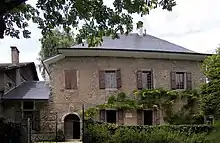Françoise-Louise de Warens
Françoise-Louise de Warens, born Louise Éléonore de la Tour du Pil, also called Madame de Warens (31 March 1699[1] – 29 July 1762[2]), was the benefactress and mistress of Jean-Jacques Rousseau.
Françoise-Louise de Warens | |
|---|---|
 Portrait de Madame de Warens, Paris 1730, peinture à l'huile de Nicolas de Largillière. | |
| Born | Françoise-Louise de La Tour 31 March 1699 Vevey |
| Died | 29 July 1762 Chambéry |
| Spouse(s) | Sébastien Isaac de Loys |
| Partner(s) | Jean-Jacques Rousseau |
| Parent(s) |
|
| Family | Anne de la Tour, Jean-Etienne de la Tour, Abraham de la Tour, Françoise-Marie de la Tour, Jacob de la Tour, Jean-Joseph de la Tour |
| Titles | baron |
Life

Warens was born in Vevey, into a Swiss Protestant family who had immigrated to Annecy. She was educated in boarding schools. In 1713, she was married to Sébastien-Isaac de Loys.
She became a Roman Catholic in 1726 in order to receive a church pension which had been instated to increase the spread of Roman Catholicism near Geneva, then a bastion of Protestantism. She had her marriage annulled.[3]
She was known to have led a liberal life for a woman of her time. She annulled her marriage to M. de Warens in 1726 after failing in a clothing business. Rousseau met her for the first time on Palm Sunday 1728. It was said that she was a spy and a converter for Savoy, then part of the Kingdom of Sardinia. In 1731, she settled at Chambéry. In 1735, she and Rousseau settled at the Domaine des Charmettes.
Though Warens was originally a teacher to Rousseau, they became sexually engaged after she openly initiated him in the matters of love and "intimacy". Françoise-Louise de Warens died in poverty in 1762 in Chambéry, of which Rousseau did not learn until six years afterwards. Rousseau describes his relationship with her in his Confessions.
Notes

- Albert Gonthier, Montreux et ses hôtes illustres, éditions Cabedita, 1999, ISBN 978-2-88295-267-7, p. 19,
- Les confessions, de Jean-Jacques Rousseau, éd. intégrale publiée sur le texte autographe conservé à la Bibliothèque de Genève, précédée d'une introduction et suivie de notes et d'un index, Publié par Garnier frères, 1930, note n° 135, page 240, voir
- Habib, Claude, ... (2012). Rousseau aux Charmettes. Frédéric Leguetteur, Promoprint). Paris: De Fallois. ISBN 978-2-87706-794-2. OCLC 795443015.
{{cite book}}: CS1 maint: multiple names: authors list (link)